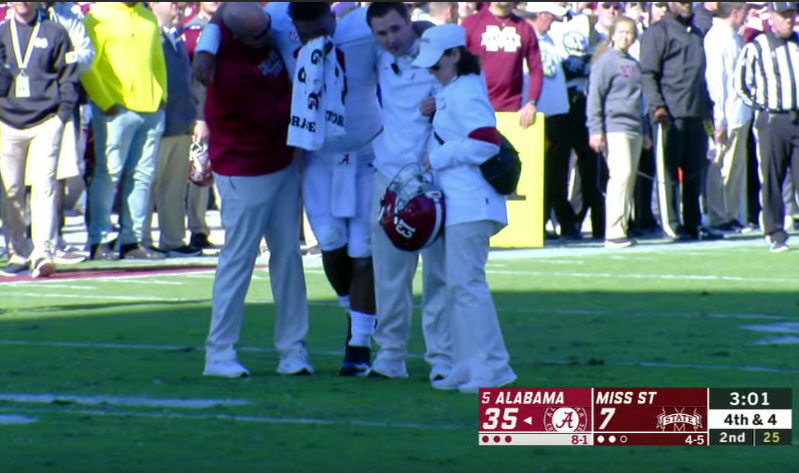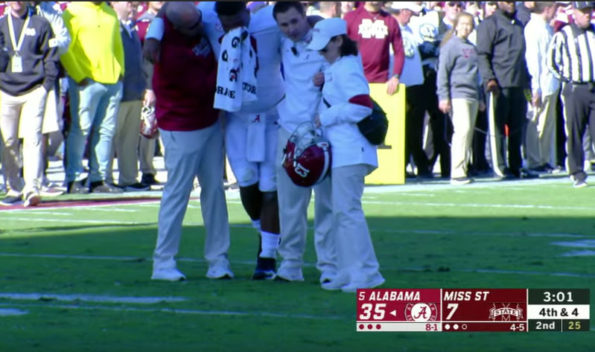
Jim Mora and Emmanuel Acho react to Alabama Crimson Tide quarterback Tua Tagovailoa leaving the game vs. Mississippi State because a hip injury, with Mora saying coach Nick Saban was shaken by the injury.
Tua Tagovailoa is a college football quarterback for the Alabama Crimson Tide. He suffered a season-ending posterior dislocation of the right hip Saturday November 16, 2019 during the Crimson Tide’s 38-7 win over Mississippi State. Tagovailoa also suffered a posterior wall fracture of his hip, according to Alabama orthopedic surgeon Dr. Lyle Cain.
Tagovailoa was injured with three minutes remaining before halftime when he was tackled by two Mississippi State Bulldogs defenders while rolling to his left on a third-down play. The two larger defensive players tackled Tua from behind while he landed with his knee driven into the ground with his femur perpendicular to the ground. The force of the impact with the weight of the opposing players on his back pushed his femur (thigh bone) through the back wall of his hip joint. He also suffered a bloody nose when his face forcefully hit the ground.
Tagovailoa was able to get on all fours, but even in that position he wasn’t able to put weight on his right knee, which was obviously rotated inward. First responders and/or trainer that responded to “help” him picked him up to a standing position when they should have stabilized and immobilized his hip. Tagovailoa couldn’t put pressure on his right leg when he was helped up by trainers. However, he should not have been “helped up” by trainers because Tagovailoa as exhibiting possible symptoms of a posterior hip dislocation. Tagovailoa was holding his leg in a flexed and fixed position with internal rotation of his knee and foot toward the midline of his body. He was also in extreme pain. He should have been immobilized and carried off on a gurney.
When a hip dislocation occurs, the ligaments, labrum, muscles, and other soft tissues holding the bones in place are often damaged, as well. The nerves around the hip, such as the sciatic nerve, may also be injured. When there is nerve damage, victim’s may not have any feeling in the foot or ankle area, or may feel numbness or tingling. A dislocated hip is an orthopedic emergency. Moving an unstable hip can cause further injury, such as permanent nerve damage or permanent disability from aggravate damage to the hip joint. Posterior hip dislocations are known risks in tackle football. They shouldn’t be a surprise to on field medical personnel.
First responders and/or trainers on the football field got him up off the ground and tried to help Tagovailoa walk. It should have been obvious to anyone qualified to assess injuries that his leg was in a position that signaled the possibility of a posterior hip dislocation. It was also obvious from the mechanism of injury (his knee driven into the ground) that he could possibly have a posterior hip dislocation. Tua was eventually airlifted back to Birmingham, Alabama for a CT scans and MRI, which confirmed the diagnosis of a posterior dislocated hip.
Also, ESPN commentators questioned Saturday whether Tua should have been on the field, because he was playing hurt and didn’t have the agility to elude even slower and larger defensive players.

^^ MOBILE? USE VOICE MIC ^^
facebook …
Please ‘LIKE’ the ‘Arlington Cardinal Page. See all of The Cardinal Facebook fan pages at Arlingtoncardinal.com/about/facebook …
Help fund The Cardinal Arlingtoncardinal.com/sponsor
20240105-1435future
THANKS FOR READING CARDINAL NEWS
ESPN personalities react to Tua Tagovailoa’s season-ending hip injury for Alabama and wonder if Nick Saban should have sat the Crimson Tide QB with a big lead against Mississippi State.
